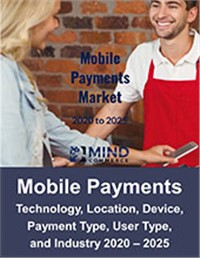This report evaluates leading mobile payment companies, strategies, and provides a market outlook with forecasts for 2020 – 2025. This includes analysis by technology, payment location, device type, payment type, and industry vertical. The report also assesses the mobile payments market for “unbanked” or “underbanked”, which is the norm for many in developing countries as well as those between the lower middle class and the poverty segment in developed countries.
The amount of commerce conducted online has grown dramatically in recent years. The use of a mobile phone and other untethered devices to conduct commerce is a natural extension of the online commerce evolution. A vast majority of these transactions rely upon some form of account settlement that usually involves credit or debit cards, checking/ACH, or bank money transfer.
Mobile payment systems rely upon use of an account system, which requires funding that can come from many different sources including a bank account, credit/debit card system, or a mobile wallet, which may be funded by various means.
Mobile payments are experiencing rapid growth as consumers use wireless devices as part of modern dynamic lifestyles. Many merchants increasingly support and encourage mobile payments because they are quick, easy, and linked to existing, well-known financial processing systems. The use of mobile payments represents an alternative to cash, cards, and even funds within the banking system. This is especially the case in developing countries where current banking services cannot reach and/or have limited access.
The unbanked population refers to the section of population that doesn’t have any relationship with normal banking services; they don’t have saving or checking accounts. The main reason for the existence of unbanked population is low income. Underbanked population refers to the section of population that have banking a relationship (checking or saving account), but use an alternative method of financial interaction rather than payments through their banking accounts.
Economic challenges are persistent in developing countries with great variation from between different countries. In India for example, the unbanked population reside mostly in rural areas, spread over large a wide area in a number of villages. This unbanked population is often poor, and hence the transactions performed through mobile banking solutions tend to be low value, as compared to metropolitan areas.
In terms of payment models, the bank-centric method, in which traditional financial institutions are relied upon for clearing and settlement, is rapidly being replaced by various third-parties in a more decentralized model that at times may involve settlement by non-financial service providers, or on a peer basis, and/or a collaborative model. The latter model is comprised of collaboration among banks, mobile operators and other stakeholders in the mobile payments value chain, including a potential trusted third party that manages the deployment of mobile applications.
While technologies used for mobile payments vary considerably, all provide solutions that provide ease of use for both remote transactions (e.g. not at the point of sale) as well as contactless payments for proximity-based payments. One such technology used for localized mobile payments is a Radio Frequency Identification (RFID) approach referred to as Near Field Communications (NFC).
NFC payment solutions enable commerce world-wide. Consumers don’t have to carry a wallet, cash, credit cards, debit cards, and they don’t need a mail routing box to receive plastic cards and bills. Increasingly, mobile phones include built-in NFC technology to interact with other mobile phones with NFC technology in addition to retail point-of-sale terminals, digital signage, and vending machines that dispense tickets, mobile devices, soft drinks, sunscreen, and toys. NFC is a successful technology for high-speed high-volume applications that is well-suited to consumer payments, especially micro-payments.
Target Audience:
- Wearable companies
- Financial institutions
- Application developers
- Mobile device vendors
- Mobile network operators
- Mobile commerce companies
- Wireless infrastructure companies
- Underbanked segment is a key segment for developed countries
- Unbanked segment is the primary market in developing countries
- Global unbanked mobile payment market will reach $307B by 2025
- Vast majority of mobile payments by volume and value are in Asia Pac
- Next gen payment technologies will be omnipresent by device and app
- Implantable tech used for personal security will be leveraged for payments



